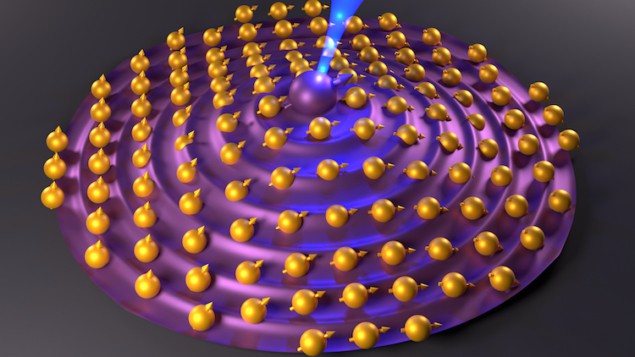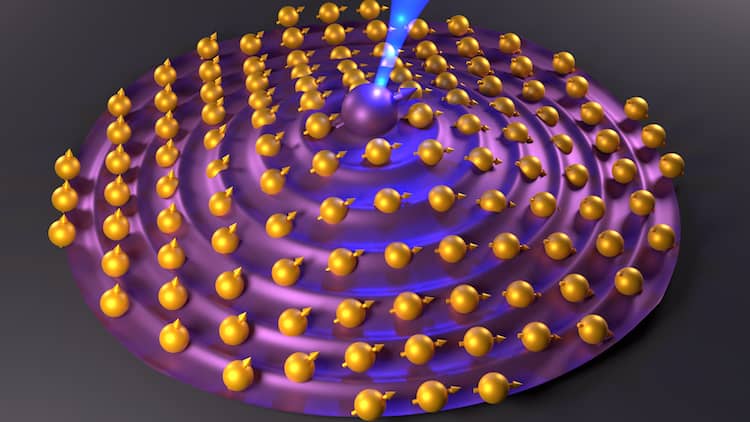
Researchers at Cambridge University in the UK have found a new way to detect a single quantum bit (qubit) hidden in a dense cloud of 100 000 qubits made from the nuclear spins of quantum dots. The feat, which involves laser light and a single electron that acts like a spin-herding “sheepdog”, might aid the development of a quantum Internet.
Quantum computers can already outperform powerful supercomputers within a narrow range of highly specialized tasks. However, for quantum devices to reach their full potential, researchers need to find some way of networking them into a quantum Internet. One route being explored would involve storing quantum information in an ensemble of coherently interacting spins. Nuclear spins in semiconductor quantum dots – tiny pieces of semiconducting crystals that act like artificial atoms – are one promising possibility.
Hiding a qubit
The problem is that the quantum information stored in the nuclear spins of these dots – or indeed the spins of any other suitable material – is fragile. One way to overcome this is to protect the information-containing spins by “hiding” them in the cloud of spins from the 100 000 atomic nuclei within each quantum dot. An information-containing spin can then be thought of as a “needle” and the cloud of other spins as a “haystack”, explains team leader Mete Atatüre, a physicist in Cambridge’s Cavendish Laboratory.
Semiconducting quantum dots lend themselves to this type of subterfuge because researchers can inject a single nuclear spin that has been excited with laser light into an ensemble of nuclear spins in the dots. In the new work, the Cambridge team injected such a single nuclear excitation, known as a nuclear magnon, into dots made of indium gallium arsenide.
So far, so good. The real hurdle, Atatüre explains, came when he and his colleagues tried to sense the presence of the stored quantum information in the ensemble of spins. This proved difficult because the spins tend to “flip” randomly when addressed, creating a noisy system. The way they got around this challenge was to use a (proxy) electron in the material that acts “like a dog that herds sheep”, as Atatüre puts it. The sheep, in this case, are the ensemble of nuclear spins.
Collective nuclear spin excitation
In their experiments, the researchers measured the spin resonance frequency of their sheepdog electron with high precision using a laser technique known as Ramsey side-of-fringe. They then used this resonance frequency to detect the excitation state of an individual nuclear spin. The detection technique only works, however, if the chaotic ensemble of nuclear spins is first cooled down to ultralow temperatures (using another beam of laser light) so that the spins begin to act as a collective nuclear spin excitation — or spin wave – with a defined state.
Atatüre explains that this is because a single nuclear spin injected into a spin wave is far easier to pick out than a spin injected into a chaotic (non-cooled) ensemble of spins. “If we imagine our cloud of spins as a herd of 100 000 sheep moving randomly, one sheep suddenly changing direction is hard to see,” he says. “But if the entire herd is moving as a well-defined wave, then a single sheep changing direction becomes highly noticeable.”

Weak measurements track single nuclear spins
By controlling the collective state of the 100 000 spins, the researchers were able to detect the existence of the stored quantum information as a flipped qubit with a precision as high as 1.9 ppm. For their apparatus, this precision represents the fundamental limit set by quantum mechanics.
Having harnessed control and sensing in such a large ensemble of nuclei, the Cambridge team says it now plans to demonstrate storage and retrieval of a full-blown arbitrary quantum bit using its technique. “Being able to do this will allow us to overcome a major building block for the quantum Internet: a deterministic quantum memory connected to light,” Atatüre tells Physics World.
The present work is detailed in Nature Physics.
